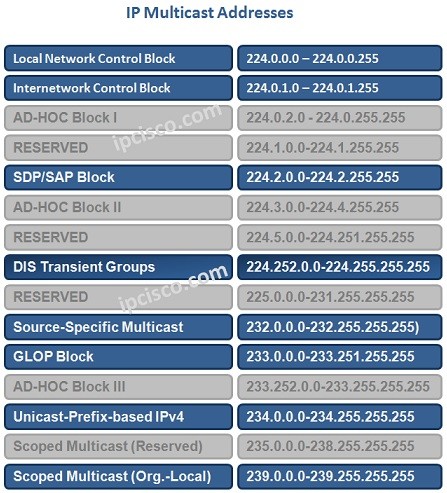- COURSES
- SPECIALS
- BLOG
- MEMBERS
- SHOP
- ABOUT
- ENROLL HERE

Multicast Addresing is the addressing that is used for Multicast Groups. We can divide Multicast Addressing into two:
These addresses identifies the destination of Multicast traffic. In other words, they show the Multicast Groups. The Multicast Source adresses uses normal addresses.
For example for IPv4, Multicast Group Addresses and the Multicast Source
Let’s see these both of these Multicast Addresses.
You can also visit Multicat MAC Address Lesson.
IPv4 Multicast Addresses are the D Class IPv4 addresses between 224.0.0.0 and 239.255.255.255. These address blocks are used for different Multicast purposes. IANA manages these address blocks
There are different sub ranges in Multicast Group Addresses. Acording to the IANA records, these Multicast Group Addresses are :
You can visit Multicast Quizes to test yourself on Multicast Lessons.
For you network certification studies and real life, you ned to know some of these ranges. But as a view, you can use the below table.

Now, let’s talk about some of these Multicast ranges detailly. We will see the Multicast ranges that we will mostly use in real life.
In the certification documents generally the below address ranges are shown. So, remembering these blocks can be useful.
Permanent Multicast addresses are between 224.0.0.0 and 224.0.1.255. They are used for Routing Protocols or for other low level protocols.
Local Network Control Block Range is the addresses between 224.0.1.0 and 224.0.0.255. Local Network Control Block addresses use TTL value 1. So, multicast routers should not forward any multicast data with destination address.
Some of the example addresses in this group are given below:
If you want to reach all Hosts on the network, you need to use 224.0.0.1,
If you want to reach all Routers on the network, you need to use 224.0.0.2,
If you want to reach all OSPF Routers on the network, you need to use 224.0.0.5,
If you want to reach all OSPF DRs on the network, you need to use 224.0.0.6,
If you want to reach all EIGRP Routers on the network, you need to use 224.0.0.10,
If you want to reach all PIMv2 Routers on the network, you need to use 224.0.0.13,
If you want to reach all ISIS Routers on the network, you need to use 224.0.0.19-21,
If you want to reach all IGMPv3 Devices on the network, you need to use 224.0.0.22.
Internetwork Control Block Range is the addresses between 224.0.1.0 and 224.0.1.255. They use a TTL value higher than 1.
Source-Specific Multicast (SSM) Range is the Multicast addresses between 232.0.0.0 and 232.255.255.255. These multicast addresses are used for Source-Specific Multicast (SSM) Applications and Protocols. SSM provide an efficient multicast routing with its mechanism. Because, with SSM, host can select the Multicast Group that it get traffic.
GLOP Block Range is the Multicast addresses between 233.0.0.0 and 233.255.255.255.These Multicast address block can be used by the companies that has registered Autonomous System Number (ASN). With this address block, each company can have up to 256 Global Multicast Addresses.
Scoped Multicast Range are the Private block of Multicast Address Range between 239.0.0.0 and 239.255.255.255. They are like Private IP address and they can be used only within the network, not globally on internet.
You can reach the whole Multicast addresses assigned by IANA below:
https://www.iana.org/assignments/multicast-addresses/multicast-addresses.xhtml
Leave a Reply